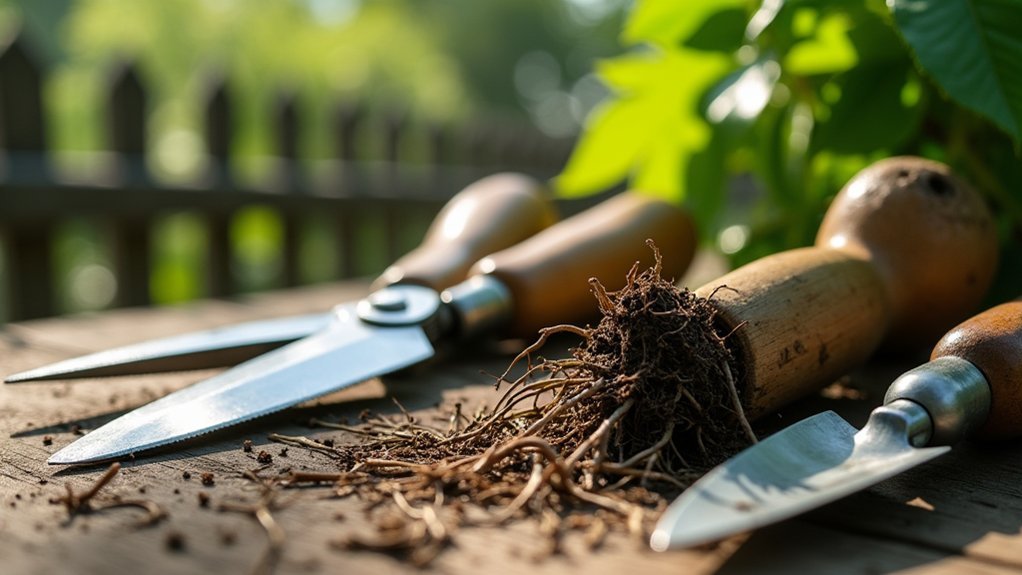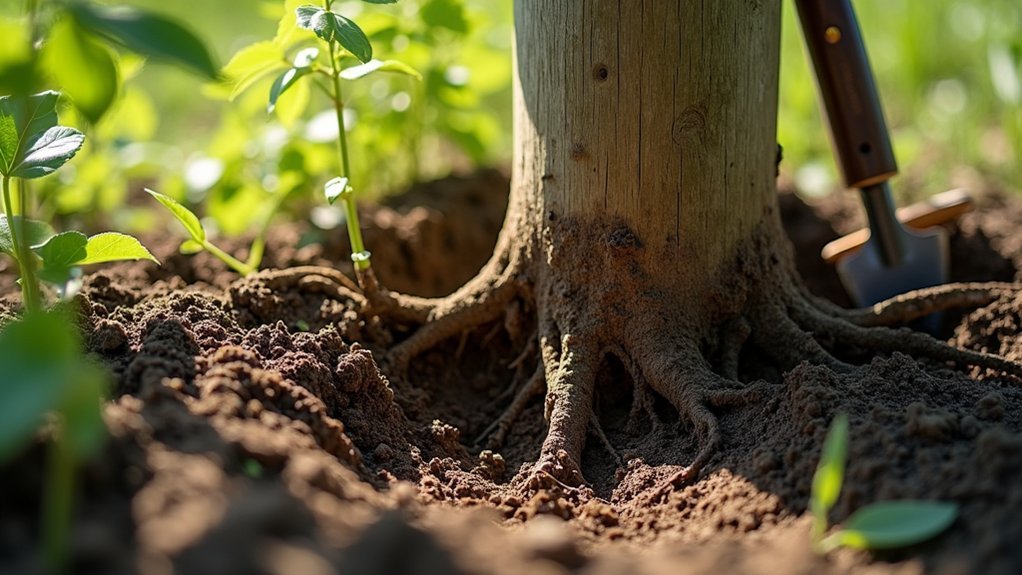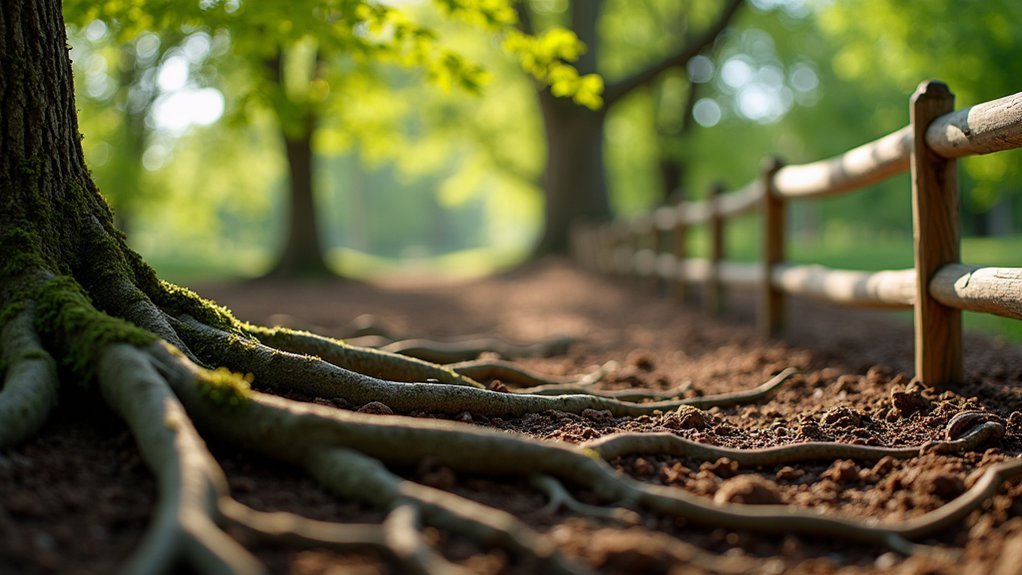For stable fence installation near trees, use sharp pruning shears for roots under 3 inches and hand saws for larger ones. Keep fence posts at least 3 feet from trunks and outside the drip line when possible. Prune during dormancy in late winter or early fall to minimize stress. Remove circling roots at their curve point using sterilized tools. After pruning, monitor soil moisture and apply mulch around posts. The right techniques guarantee both healthy trees and enduring fences.
Precision Hand Tool Techniques for Preserving Root Integrity

When approaching root pruning for fence stability, selecting the right hand tools becomes essential for maintaining tree health while creating space for your structure.
Choose pruning shears for roots under 3 inches in diameter and small hand saws for moderately sized roots requiring delicate cuts.
Make clean cuts to prevent bark tearing and excessive exposure. Position your tools at proper angles to achieve precise cuts without disturbing nearby roots. For thicker roots, use incremental cuts to control depth and minimize shock. Klein Tools’ Straight-Claw Hammer provides excellent leverage when you need to carefully separate soil from roots before cutting. Avoid roots larger than 3 inches to maintain structural stability.
Always keep your blades sharp to guarantee smooth cuts, reducing stress and infection risk. After pruning, spray exposed fine roots with protective substances or keep them moist to prevent drying.
Prune outside the tree’s dripline to preserve the essential root system.
Safe Distance Guidelines for Root Pruning Near Fence Lines
Establishing proper spacing between your fence and nearby trees represents the foundation of successful root pruning. Follow the canopy-based rule by maintaining distance of at least half the tree’s expected mature spread from fence lines.
For more precision, measure the trunk diameter and multiply by five—this gives you the minimum safe radius for digging (a 20-inch tree requires at least an 8.3-foot buffer).
When installing fence posts, leave at least 3 feet from trunks and avoid excavating within the drip line where structural roots predominate.
If you must trench near trees, keep depths under 12 inches and angle paths away from high-density root areas. Species with aggressive root systems, like willows and maples, require even greater caution when pruning near fence structures.
Remember that most trees can only tolerate losing 20-30% of their root mass without suffering decline or instability.
Managing Circling Roots and Girdling Patterns During Fence Installation

Properly identifying and managing circling roots and girdling patterns represents a critical step in successful fence installation near trees.
Begin by conducting thorough root collar examinations and washing roots to expose problematic growth patterns before installation.
When you discover circling roots, prune them at the point of curvature using sterilized tools.
Implement spoke pattern pruning to encourage outward growth and remove any crossed or layered roots that compromise structural integrity.
During fence installation, use post pounders instead of augers near root zones and relocate post holes if you encounter roots thicker than 1″ in diameter.
The transition zone where roots spread from the trunk, known as the root flare, should be kept visible to prevent future girdling problems.
Consider installing vertical root barriers between trees and fence lines when necessary.
Maintain consistent soil grade during construction and avoid burying trunk flares when backfilling, which can lead to future girdling issues.
Seasonal Timing Strategies for Minimal Root System Disturbance
Selecting the right season for root pruning dramatically impacts tree health and fence stability. Time your interventions during the dormant phase in late winter to minimize stress and allow for spring regeneration, or choose early fall when trees can recover before frost sets in.
Avoid pruning during active growth periods or dry seasons, as this disrupts nutrient flow and increases dehydration risk. For deciduous trees, aim for January-February, while evergreens prefer March-April pruning. Wait until post-bloom for flowering species.
Ensure 48-hour dry periods before and after pruning to prevent pathogen introduction. Don’t prune when temperatures fall below 40°F or exceed 90°F. Proper pruning techniques enable trees to develop new root formation that will provide greater stability over time.
For fence projects, follow trunk diameter measurements to determine safe pruning distances—approximately 8-12 inches per inch of trunk diameter.
Post-Pruning Care Methods to Ensure Long-Term Fence Stability

The success of your fence installation hinges on diligent post-pruning care that addresses both soil health and structural integrity.
After root pruning, monitor soil moisture carefully—avoid overwatering while ensuring adequate hydration for recovery. Apply mulch around fence posts to regulate soil temperature and moisture levels.
Balanced soil moisture is crucial post-pruning—maintain hydration without saturation and use mulch to create optimal recovery conditions.
Incorporate compost to improve soil structure and fertilize appropriately to support root regrowth. Choose fertilizers that enhance root development and adjust based on soil pH for peak absorption. Early detection of plant stress indicators such as wilting or yellowing can help you adjust your care routine before problems worsen.
During the recovery period, provide temporary support to fence posts if needed to prevent wind damage.
Conduct regular inspections of your fence, looking for signs of shifting or instability. Apply preservatives to wooden components and fill gaps to prevent decay.
These maintenance practices will greatly extend your fence’s stability and lifespan.
Frequently Asked Questions
Can Fence Installation Be Done Without Any Root Pruning?
Yes, you can absolutely install fences without root pruning by using no-dig methods like driven steel posts, sleeve systems, ground anchors, or redirecting your fence line to avoid tree roots entirely.
How Do Root Barriers Affect Fence Stability Over Time?
Root barriers can improve your fence’s stability over time by redirecting aggressive roots downward. You’ll see less heaving and pushing against posts, but you’ll need properly installed, deep barriers for long-term effectiveness.
Will Chemical Root Growth Inhibitors Damage My Fence Posts?
No, chemical root growth inhibitors won’t damage your fence posts directly. They target plant cellular processes, not wood or metal structures. However, they might reduce soil stability around posts by limiting root development.
Are Metal Fence Posts Less Disruptive to Roots Than Wooden Ones?
Yes, metal fence posts are less disruptive to roots than wooden ones. You’ll damage fewer roots during installation since metal posts require smaller holes and won’t need replacement as often, minimizing repeated root disturbance.
Can Mycorrhizal Fungi Applications Help Roots Recover After Fence Installation?
Yes, mycorrhizal fungi applications can help your roots recover after fence installation. They’ll enhance nutrient uptake, improve soil structure, and accelerate healing of damaged root systems through their extensive hyphal networks.
In Summary
You’ve now mastered the essential root pruning methods to protect both your trees and fences. Remember, it’s not just about cutting—it’s about precision, timing, and aftercare. By maintaining proper distances and using the right tools, you’ll prevent future damage. Apply these techniques seasonally, watch for warning signs, and you’ll enjoy stable fences alongside healthy trees for years to come.





Leave a Reply